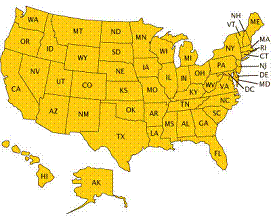Mike Holt’s Rating of the Electrical Industry 2nd Draft
Thank you to everyone that provided feedback during the last installment of Mike Holt’s Rating of the Electrical Industry. Based on feedback we received, we revised our report for 2007.

If you disagree with any of the findings (click here or on the link below to see how the rankings were determined) please send us information from your state that can help us update our information.
Inspectors - Per your request we have included Inspectors and Inspector CEU in this report, however we were unable to come by all of the Inspector information we need so we have not factored this into the rating yet. If you can help us to fill in the blanks in any of the “?” areas under Inspector or Inspector CEU we would greatly appreciate that.
Puerto Rico - An additional request was to add Puerto Rico to this report. If you can, help us to fill in the blanks in any of the “?” areas under Puerto Rico.
Congratulations to Arkansas, Nebraska, New Hampshire, North Dakota, Oregon, and South Dakota for their “A+” rating. These states have set the standard for electrical safety by adopting the most current Code on a state-wide level, requiring licensing for Apprentices, Journeymen, Master Electricians, Professional Engineers, as well as requiring continuing education at the state level for all of these classifications.
Canada - We were told during the last review that Canada meets all of these requirements and have found some support for most of this in the Electrical Licensing Act of Canada. If however, we have a Canadian expert out there that can confirm this that would be greatly appreciated.
Alabama |
B |
Alaska |
B |
Arizona |
F+ |
Arkansas |
A+ |
California |
B+ |
Colorado |
C |
Connecticut |
B+ |
DC |
C |
Delaware |
B |
Florida |
B+ |
Georgia |
B+ |
Hawaii |
B |
Idaho |
A |
Illinois |
F+ |
Indiana |
D+ |
Iowa |
F+ |
Kansas |
D+ |
Kentucky |
B+ |
Louisiana |
C |
Maine |
A |
Maryland |
F+ |
Massachusetts |
A |
Michigan |
B+ |
Minnesota |
A |
Mississippi |
D |
Missouri |
D |
Montana |
B+ |
Nebraska |
A+ |
Nevada |
D+ |
New Hampshire |
A+ |
New Jersey |
B |
New Mexico |
A |
New York |
D |
North Carolina |
B+ |
North Dakota |
A+ |
Ohio |
B+ |
Oklahoma |
A+ |
Oregon |
A+ |
Pennsylvania |
D+ |
Rhode Island |
A |
South Carolina |
C+ |
South Dakota |
A+ |
Tennessee |
C |
Texas |
A |
Utah |
A |
Vermont |
A |
Virginia |
C |
Washington |
B+ |
West Virginia |
C+ |
Wisconsin |
B |
Wyoming |
A |
Puerto Rico |
TBD |
Canada |
A+ |
Click Here to view the spreadsheet detailing our analysis.